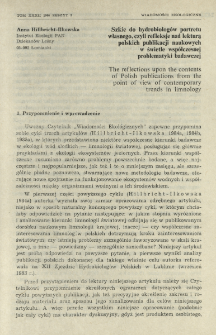
Obiekt
Tytuł: Szkic do hydrobiologów portretu własnego, czyli refleksje nad lekturą polskich publikacji naukowych w świetle współczesnej problematyki badawczej
Inny tytuł:
Szkic do hydrobiologów portretu własnego... ; Reflections upon the contents of Polish publications from the point of view of contemporary trends in limnology
Współtwórca:
Polska Akademia Nauk. Komitet Ekologii
Wydawca:
Miejsce wydania:
Opis:
Strony 241-265 ; 24 cm ; Bibliografia na stronach 263-264 ; Streszczenie w języku angielskim
Typ obiektu:
Abstrakt:
A dozen or so limnological problems have been distinguished (Figs. 1—4) as described in previous articles of the series (Hillbricht-Ilkowska 1984a, 1984b, 1985a) as contemporary, more common trends in world limnology. The interest in these problems among Polish limnologists has been analysed by reviewing 445 literature items (papers published and reports at conferences) for years 1979—1982 and 397 items for years 1982—1985 as a result of reviewing several Polish hydrobiological, ecological and fishery journals as well as a score of sets of non-periodical publications (see literature references) and report summaries for meetings and congresses. These data were compared with contents of 600 reports at XXIInd International Congress of Limnology (SIL) in Lyon (August 1983). According to problems distinguished and to the article aim analysis was restricted only to papers on inland waters ecology (limnology) written by Polisih scientists, with each paper being ascribed to one problem in accordance with its main content or aim. Distribution of interests among the problems distinguished was characterised in each group by percentage. It was observed that consequently along the last decade about half of all meeting reports or publications (Fig. 1) is devoted to problems of all kinds of anthropopressure or changes in aquatic ecosystems connected with impact of human activity. In this fundamental problem, most of interest is focussed on eutrophication phenomena, and most frequent studies concerned effects, monitoring and bioindication. The monitoring approach in fundamental problem “anthropopressure”, eutrophication included, is in national limnology more common than in the world data set (reports for the SIL Congress). This pertains also to the effect of heated waters and changes caused by hydrotechnics. The interest in the sphere beyond the registering of the effects of eutrophication, i.e. in experimenting, prognosis, modelling, problem of hypertrophy, watershed and airshed impact as well as investigations of cycling and retention of nutrients in ecosystems and recultivation is represented in the manner similar to the world situation (periodically somewhat weaker) (Fig. 2). However, there is a lack in national limnology of significant interest in effects of acidification and anthropogenie mineralization of surface waters. Besides eutrophication (and anthropopressure in generał) large and constant share of interest by national limnologists (always larger than in world scale) is focussed on comparative description of communities and occurrence of species in various habitats as well as the problem of fish effect (herbivorous fish and the impact of aquaculture) on aquatic ecosystems considered from the point of view of pollution and eutrophication (Fig. 3). Permanently lower attention of the national limnology is paid to problems of “water-bottom sediment system”, of heterogeneity of aquatic habitats (temporal-spatial phenomena of meso- and microscale), structuring impact of predators and consumers on communities they prey upon and life strategies of organisms and communities under altered food conditions, competitive tension, predators’ pressure and habitat variability (Figs. 3, 4). In national limnology there is no new methodological approach in studies of running waters as connected with the concept of river continuum and nutrient spiralling. One can be afraid that the progress in the national limnology in these lines will be quite mediocre and not catching up with the development of world ecology. […]
Czasopismo/Seria/cykl:
Tom:
Zeszyt:
Strona pocz.:
Strona końc.:
Szczegółowy typ zasobu:
Identyfikator zasobu:
oai:rcin.org.pl:206973 ; 0013-2969
Źródło:
MiIZ PAN, sygn. P.3259 ; kliknij tutaj, żeby przejść
Język:
Język streszczenia:
Prawa:
Licencja Creative Commons Uznanie autorstwa 3.0 Polska
Zasady wykorzystania:
Zasób chroniony prawem autorskim. [CC BY 3.0 PL] Korzystanie dozwolone zgodnie z licencją Creative Commons Uznanie autorstwa 3.0 Polska, której pełne postanowienia dostępne są pod adresem: ; -
Digitalizacja:
Muzeum i Instytut Zoologii Polskiej Akademii Nauk
Lokalizacja oryginału:
Biblioteka Muzeum i Instytutu Zoologii PAN
Dofinansowane ze środków:
Dostęp:
Kolekcje, do których przypisany jest obiekt:
- Repozytorium Cyfrowe Instytutów Naukowych > Kolekcje Partnerów > Muzeum i Instytut Zoologii PAN > Czasopisma
- Repozytorium Cyfrowe Instytutów Naukowych > Piśmiennictwo > Czasopisma/Artykuły
Data ostatniej modyfikacji:
4 lut 2022
Data dodania obiektu:
27 sie 2021
Liczba pobrań / odtworzeń:
33
Wszystkie dostępne wersje tego obiektu:
https://www.rcin.org.pl/publication/152036
Wyświetl opis w formacie RDF:
Wyświetl opis w formacie RDFa:
Wyświetl opis w formacie OAI-PMH:
Obiekty Podobne
Hillbricht-Ilkowska, Anna
Hillbricht-Ilkowska, Anna
Hillbricht-Ilkowska, Anna
Hillbricht-Ilkowska, Anna
Hillbricht-Ilkowska, Anna
Hillbricht-Ilkowska, Anna
Hillbricht-Ilkowska, Anna
Hillbricht-Ilkowska, Anna

 INSTYTUT ARCHEOLOGII I ETNOLOGII POLSKIEJ AKADEMII NAUK
INSTYTUT ARCHEOLOGII I ETNOLOGII POLSKIEJ AKADEMII NAUK
 INSTYTUT BADAŃ LITERACKICH POLSKIEJ AKADEMII NAUK
INSTYTUT BADAŃ LITERACKICH POLSKIEJ AKADEMII NAUK
 INSTYTUT BADAWCZY LEŚNICTWA
INSTYTUT BADAWCZY LEŚNICTWA
 INSTYTUT BIOLOGII DOŚWIADCZALNEJ IM. MARCELEGO NENCKIEGO POLSKIEJ AKADEMII NAUK
INSTYTUT BIOLOGII DOŚWIADCZALNEJ IM. MARCELEGO NENCKIEGO POLSKIEJ AKADEMII NAUK
 INSTYTUT BIOLOGII SSAKÓW POLSKIEJ AKADEMII NAUK
INSTYTUT BIOLOGII SSAKÓW POLSKIEJ AKADEMII NAUK
 INSTYTUT CHEMII FIZYCZNEJ PAN
INSTYTUT CHEMII FIZYCZNEJ PAN
 INSTYTUT CHEMII ORGANICZNEJ PAN
INSTYTUT CHEMII ORGANICZNEJ PAN
 INSTYTUT FILOZOFII I SOCJOLOGII PAN
INSTYTUT FILOZOFII I SOCJOLOGII PAN
 INSTYTUT GEOGRAFII I PRZESTRZENNEGO ZAGOSPODAROWANIA PAN
INSTYTUT GEOGRAFII I PRZESTRZENNEGO ZAGOSPODAROWANIA PAN
 INSTYTUT HISTORII im. TADEUSZA MANTEUFFLA POLSKIEJ AKADEMII NAUK
INSTYTUT HISTORII im. TADEUSZA MANTEUFFLA POLSKIEJ AKADEMII NAUK
 INSTYTUT JĘZYKA POLSKIEGO POLSKIEJ AKADEMII NAUK
INSTYTUT JĘZYKA POLSKIEGO POLSKIEJ AKADEMII NAUK
 INSTYTUT MATEMATYCZNY PAN
INSTYTUT MATEMATYCZNY PAN
 INSTYTUT MEDYCYNY DOŚWIADCZALNEJ I KLINICZNEJ IM.MIROSŁAWA MOSSAKOWSKIEGO POLSKIEJ AKADEMII NAUK
INSTYTUT MEDYCYNY DOŚWIADCZALNEJ I KLINICZNEJ IM.MIROSŁAWA MOSSAKOWSKIEGO POLSKIEJ AKADEMII NAUK
 INSTYTUT PODSTAWOWYCH PROBLEMÓW TECHNIKI PAN
INSTYTUT PODSTAWOWYCH PROBLEMÓW TECHNIKI PAN
 INSTYTUT SLAWISTYKI PAN
INSTYTUT SLAWISTYKI PAN
 SIEĆ BADAWCZA ŁUKASIEWICZ - INSTYTUT TECHNOLOGII MATERIAŁÓW ELEKTRONICZNYCH
SIEĆ BADAWCZA ŁUKASIEWICZ - INSTYTUT TECHNOLOGII MATERIAŁÓW ELEKTRONICZNYCH
 MUZEUM I INSTYTUT ZOOLOGII POLSKIEJ AKADEMII NAUK
MUZEUM I INSTYTUT ZOOLOGII POLSKIEJ AKADEMII NAUK
 INSTYTUT BADAŃ SYSTEMOWYCH PAN
INSTYTUT BADAŃ SYSTEMOWYCH PAN
 INSTYTUT BOTANIKI IM. WŁADYSŁAWA SZAFERA POLSKIEJ AKADEMII NAUK
INSTYTUT BOTANIKI IM. WŁADYSŁAWA SZAFERA POLSKIEJ AKADEMII NAUK


































